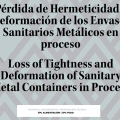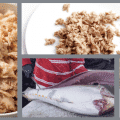Last month I published an article in networks, about a very particular case, where a good friend asked me about how he could increase his production of canned food in jars, where he packaged mackerel fillets, bonito, tuna, frigate tuna and other hydrobiological species in olive oil. He sent me photos of what he had produced and the product looked quite well presented, his next step would be to package these same fillets in RO125 metal containers.
Logically I asked him to detail his production flow, to evaluate at what stage of the process could be implemented some opportunity for improvement and make their production more efficient. What caught my attention the most was the temperature and the time used in the thermal treatment, because the jars, once filled and closed, were introduced into a simple pot with water, which after boiling at 100 °C (212 °F), they were kept there for 100 minutes. With this information I performed a freehand lethality calculation, assuming at the coldest point (cold spot) of the fish fillets 99.5 °C (211.10 °F) for 100 minutes and got a Fo of 0.7 using the general Bigelow method, with 12 decimal reductions of Clostridium botulinum, (12D Concept / 121.1 °C and Z=10 °C) applied to Low Acid Canned Foods (LACF), as fish fillets usually end up with a final stabilized pH of at least 5.9. These LACF preserves must be brought to a Fo of 4 or 5, but in order to reach that level of lethality the jars with the fillets in olive oil should have been boiled for at least 570 minutes, these times are unfeasible industrially, so, in order to reduce them, the LACF preserves are processed at high temperatures, always above 100 °C (212 °F), usually between 115 and 120 °C (239 and 248 °F) and corresponding saturated steam gauge pressures of 10 and 14 psi respectively, using pressure cookers, autoclaves or retorts that use saturated steam, water spray or superheated water as the heating medium.
I asked him why he had decided to give his preserves such a mild heat treatment, closer to pasteurized than sterilized, and he answered me that on YouTube he had found several artisanal recipes for tuna in olive oil, dull bonito and others that even considered shorter processing times in boiled water. Logically, I saw them and I was very shocked with their content, because they were pasteurizing a LACF and at any moment a sanitary alert for botulism could appear, which is the most serious food-borne disease (ETA), because it can cause the death of the consumer.
I considered it pertinent to publish this article because of the dangerous consequences to public health that can result from the indiscriminate production of artisanal canned food and in response I received some questions on the subject that I will try to clarify below. If in the end there are still any questions, I will be happy to clarify them by e-mail or through Mundolatas.
What is botulism?
Botulism is a serious TAD, caused by a toxin that attacks the body’s nerves. It can cause difficulty swallowing or speaking, facial weakness on both sides of the face, blurred or double vision, drooping eyelids, breathing problems, muscle paralysis, and even death. The toxin is most often produced by the bacteria Clostridium botulinum and inadequately packaged, preserved or artisanally fermented canned foods can create the conditions necessary for the bacteria to produce the toxin, which can cause the bacteria to produce the toxin. you can’t see it, smell it, or taste it; but tasting even a small amount of food with this toxin can be deadly.
There are several factors that can hinder the development of Clostridium botulinum in food, as it is not a good competitor in the presence of other microorganisms: pH below 4.5 prevents its multiplication, humidity below 9% prevents the availability of water for its survival, water activity (aw) lower than 0.93 is limiting, salt concentrations (NaCl) higher than 8% prevent the production of the toxin. It is important to remember that apparent changes in food, such as odor, taste, color and texture, do not always occur, just as canned foods containing contaminated food may not always have swollen lids.
The most frequent cases of botulism have occurred in artisanal canned foods produced from low-acid or LACF foods that end up with a final stabilized pH above 4.6; this includes meats, fish, seafood, asparagus, peas, beans, corn, figs, milk, etc. and the most common cause is that the processed canned foods have been subjected to only mild heating in boiled water at 100°C (212°F) as if pasteurized, which eliminates only the live or viable fermentative microorganisms present in the food. For low-acid canned foods, sterilization or heating at high temperatures and corresponding pressures above atmospheric pressure is mandatory to eliminate bacterial spores or seeds, since Clostridium botulinum is a sporulating anaerobe.
What is the difference between pasteurized and sterilized?
The purpose of both thermal treatments is to provide the canned food with the calculated or programmed microbiological stability, eliminating all microorganisms or bacteria present in the food and that are a risk to public health, in order to keep them safe and suitable for direct human consumption throughout their shelf life.
Pasteurizing heats canned foods to no more than the temperature of boiling water, 212 °F (100 °C) or less. It eliminates enzymes, fungi, yeasts, viable bacteria and some fungal spores such as those of Byssochlamys fulva, which is the reference microorganism for calculating commercial sterility in pasteurized preserves. What is vital for the food safety of this type of canned food is that its final stabilized pH is no higher than 4.5, since this level of acidity will not allow the activation of bacterial spores that cause botulism. Pasteurization is efficient for acid and acidified preserves, such as fruit juices, gherkins, sauerkraut, applesauce, acidified palm hearts, burnt peppers and others.
Sterilizing, on the other hand, heats the canned food between 115 and 120 °C (239 and 248 °F). It eliminates enzymes, all microorganisms destroyed by pasteurization and additionally the spores of Clostridium botulinum that when activated could produce the deadly botulinum toxin. The final stabilized pH of these preserves can be above 4.6 and their commercial sterility and food safety is guaranteed for up to four years under normal storage conditions. Sterilization is efficient for canned poultry, beef, pork, pork, tuna, bonito, mackerel, salmon, as well as vegetables such as potatoes, asparagus, corn and others.
What is Fo in canned food?
To make it more didactic, we can state that Fo denotes in minutes the levels of commercial sterility or microbiological lethality that has been reached in the canned food once the heating or heat treatment has been completed. Depending on whether pasteurized or sterilized, the Fo values (121.1 °C and Z= 10 °C) range from 0.5 with mild processes to values of 6 or 8 for sterilized preserves; the more resistant the microorganism, the higher the Fo should be. At this point it should be clarified that low-acid canned foods such as mackerel, tuna, bonito, frigate tuna in olive oil should be sterilized with minimum values of Fo 4 to 5 to destroy the spores of Clostridium botulinum that are heat-resistant, otherwise this microorganism can reactivate producing the deadly botulinum toxin.
Its general formula is Fo = D (log a – log b); where D is the thermal resistance of the microorganism to be destroyed, log a the initial number of bacteria and log b the final number which is usually 1. From this it follows that the higher the thermal resistance of the microorganism, the higher the Fo should be.
12
Clostridium botulinum spores and 1 spore may remain as the commercial sterilization is not total. Here we have to consider that the decimal logarithm of 1 is finally zero.
The calculation of Fo in canned food is a scientific method that is performed by a thermal processing authority with heat penetration studies, placing temperature sensors or thermocouples at the coldest point of the food to record minute by minute the temperature increase during the entire heating process. For calculation purposes we can state that if the food is heated for 1 minute at 121.1 °C (250 °F) then the Fo is equal to 1. But here the other question arises…; why if I sterilize below 121.1 °C do I have Fo values? And the answer is that above 100 °C (212 °F) there are already minimum lethality or Fo values that add up minute by minute in a cumulative manner throughout the heat treatment and even during the cooling phase.
Why do some artisanal preserves not spoil and do not produce botulism?
Because the heat treatment or heating of LACF canned food that I have been able to verify on YouTube, is done in boiled water at 100 ° C (212 °F) for a certain time, which in some cases reaches up to 120 minutes and this process corresponds to a typical pasteurized, where all the enzymes that produce autolysis or self-digestion of food are eliminated, all viable or live microorganisms are also eliminated, What cannot be eliminated are a large number of heat-resistant spores, such as Clostridium botulinum, which causes botulism, and some thermophiles such as Bacillus stearothermophilus, which causes simple fermentation or flat souring without gas formation. All these remaining spores remain in a state of latency waiting for the right moment to become active, until then the preserves will not be damaged and will not produce botulism.
Performing lethality calculations (General Method) to artisanal preserves, I have verified that they reach at most a Fo (121.1 °C and Z= 10 °C) of 0.7 to 0.8 and in the best of the cases they eliminate 10
4
Clostridium botulinum spores, when the minimum established to achieve commercial sterility in low-acid canned foods is to destroy 10
12
spores, with these exiguous values of Fo they complete only a third of the standard process accepted at international level. In this scenario we simply go back to the time of Nicolas Appert (1810), where the theory of spontaneous generation was still in force and the manufacture of food preserves was purely experimental, based on trial and error, which meant that sometimes it worked and sometimes it did not, some preserves did not deteriorate and others did.
What is dangerous in the production of homemade preserves is that some of them remain unalterable, do not deteriorate and do not produce botulism, so that a false sense of food safety is generated in the culinary environment of home canning, both in the producer and in the consumer. Critically, a health alert for botulinum poisoning could be issued at any time with serious public health consequences.
What can you suggest or recommend to produce safe artisanal canned food?
Here are some recommendations for producing safe artisanal canned goods:
- I personally recommend that the time and temperature parameters used in the pasteurization or sterilization of artisanal canned food be defined by an institute or university specializing in the Heat Treatment of Canned Food (TTCA). Otherwise consult a processing authority for further instructions.
- Culinary schools for the training of professional cooks or chefs, as well as associations of artisanal canners, should be given introductory training in TTCA.
- Remember that the canned food can only be heated in boiled or pasteurized water when the food finally reaches an acidity or pH of 4.5 or less, if the acidity or pH is higher, then heating the canned food will have to be done above 100 °C (212 °F).
- All artisanal canning using meat products such as beef, chicken, pork, fish and others should be sterilized, as mentioned above, between 115 and 120 °C (239 and 248 °F), using pressure cookers, pressurized heaters, autoclaves, which use steam or water reheated under pressure.
- I recommend carefully following the instructions for safe home canning in the USDA’s “Complete Guide to Home Canning.
- It is clear that it should be discarded to consume artisanal canned food that have the lid lifted, that drip liquid, that present superficial foam when opened, that the food has changed color, flavor or has an abnormal and unexpected strange smell.
- If there is any doubt about the presence of botulinum toxin in a canned food, it is recommended to boil the food in a pot at 100 °C (212 °F) for 10 minutes to inactivate the botulinum toxin, since it is a thermolabile protein unable to withstand high temperatures.
Carlos Herrera
Mundolatas Advisor















0 Comments